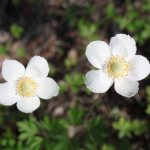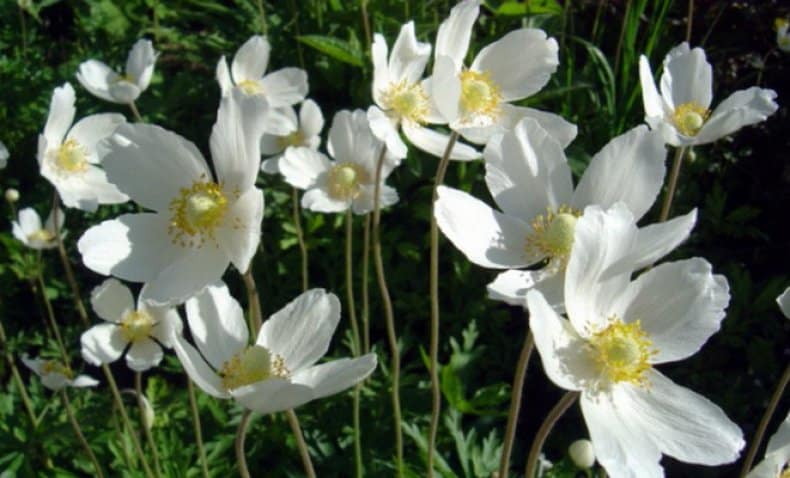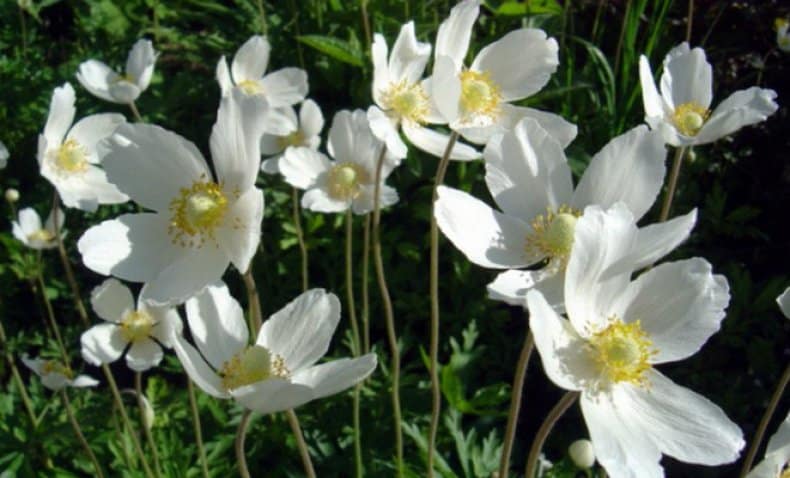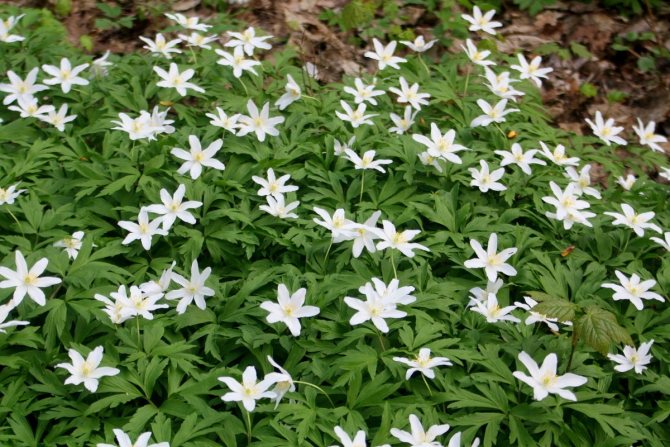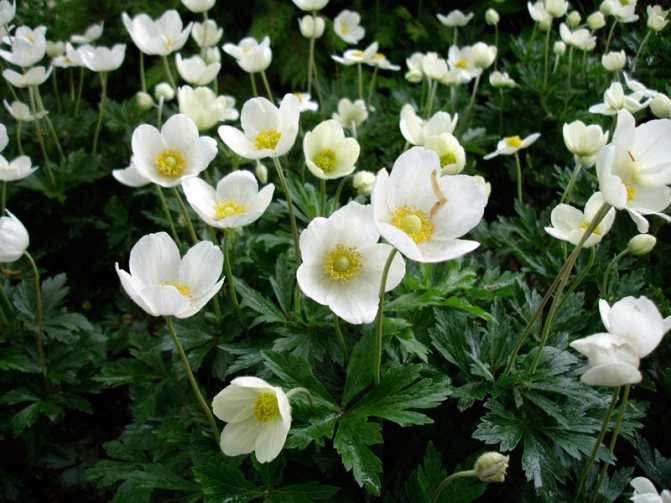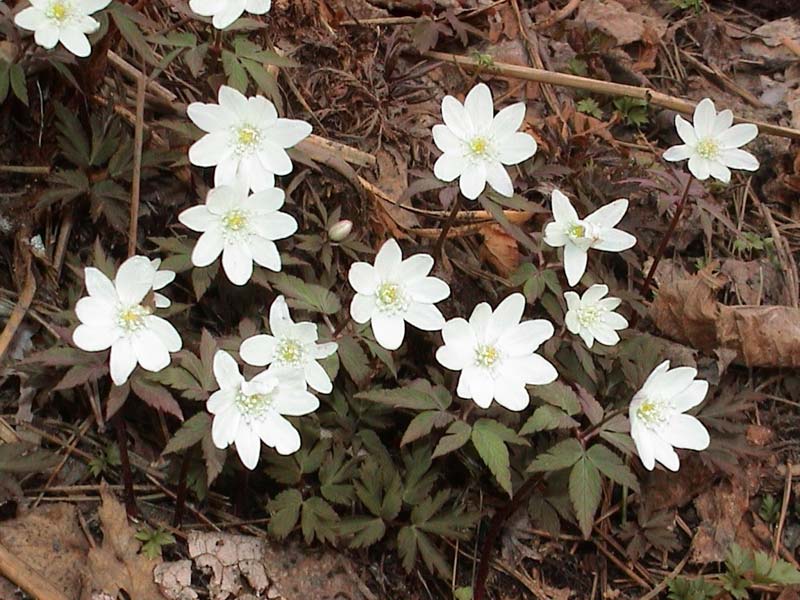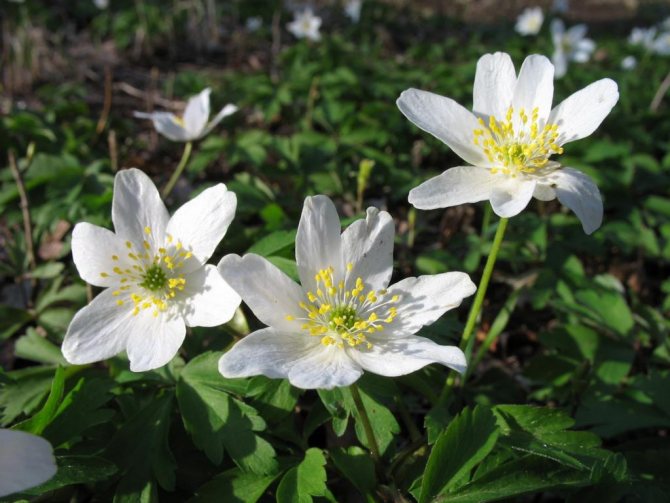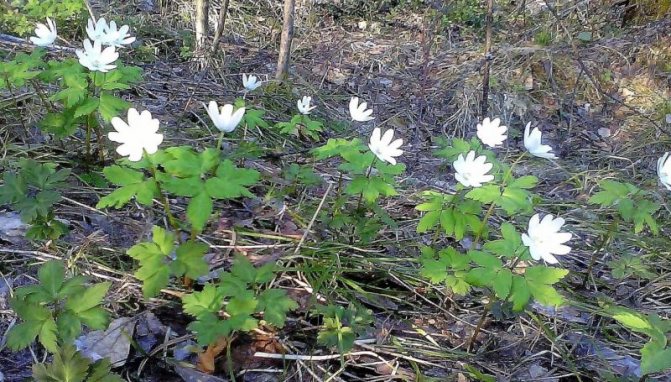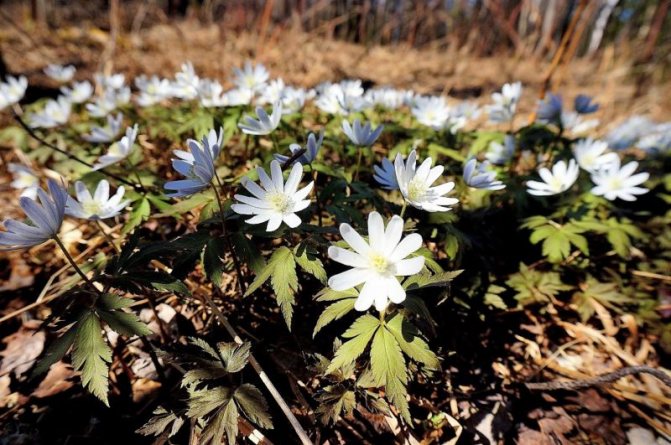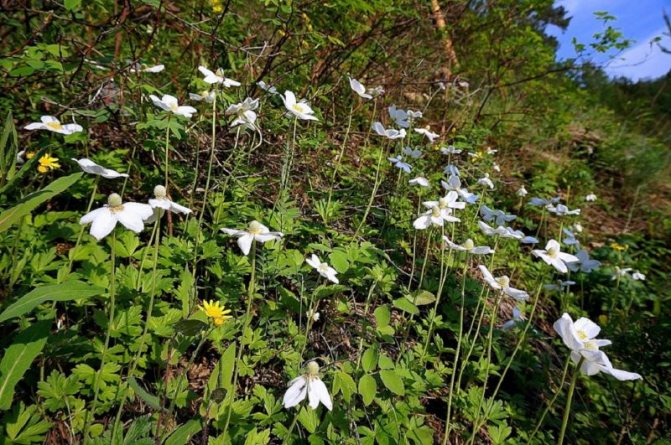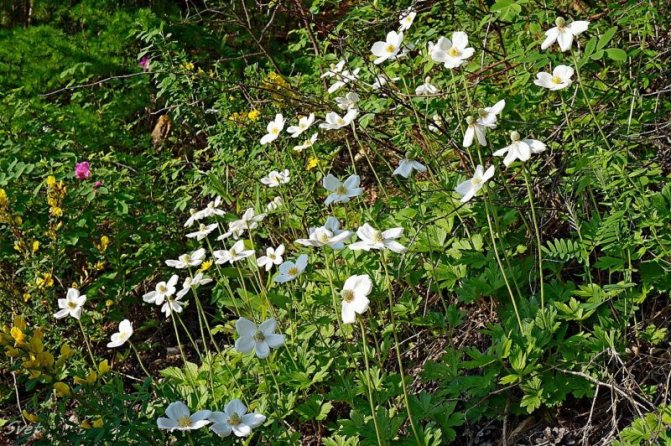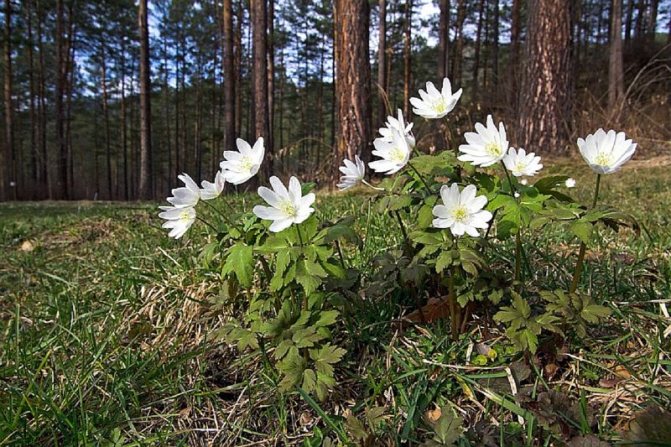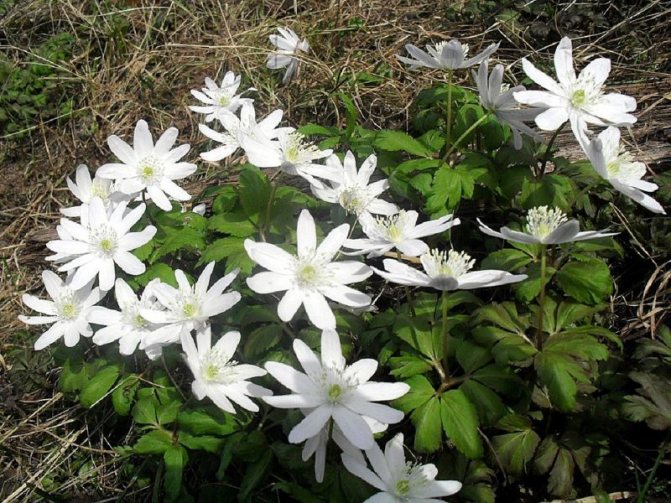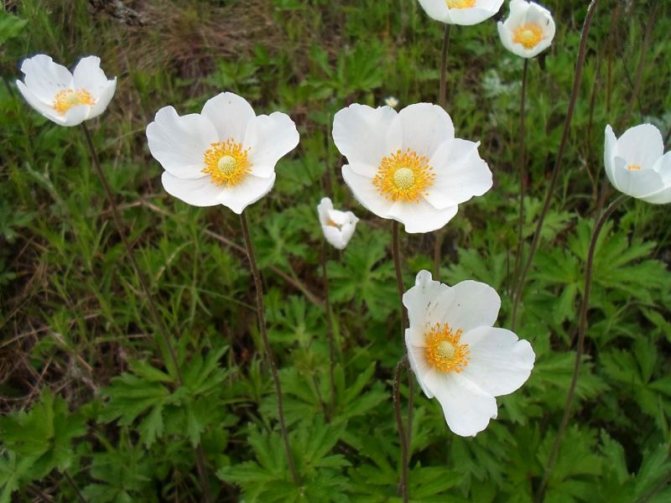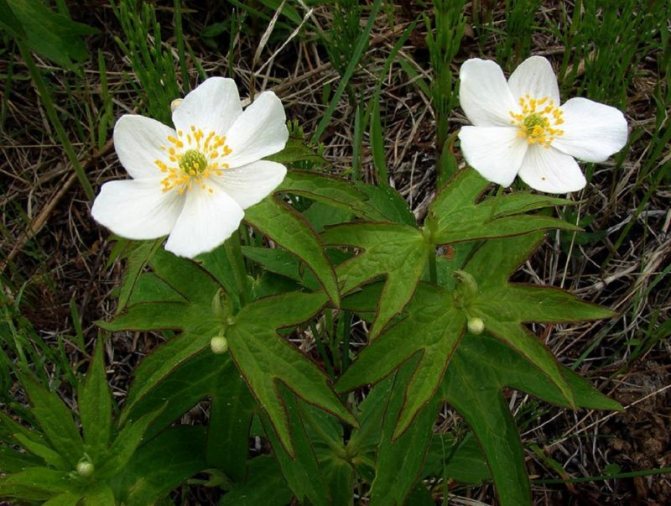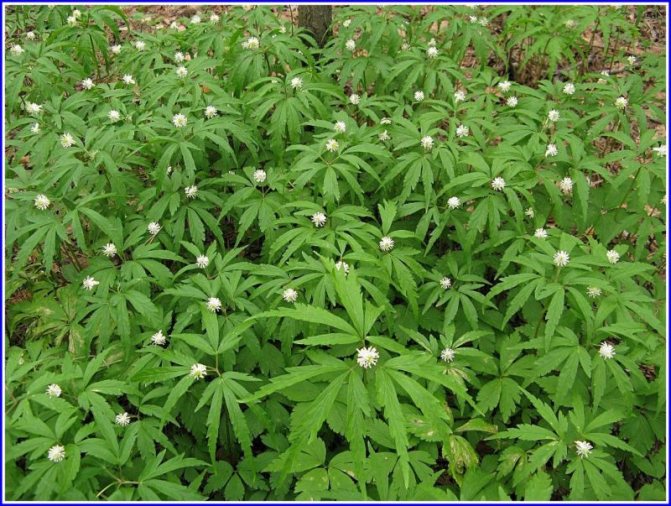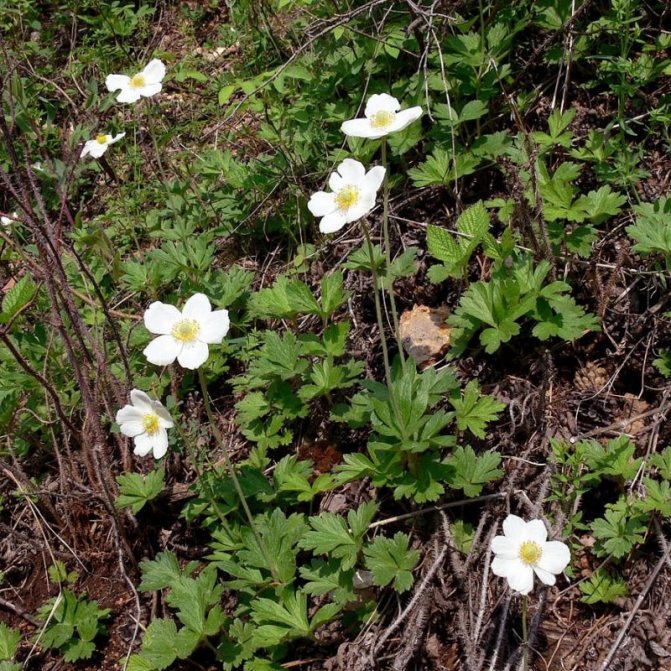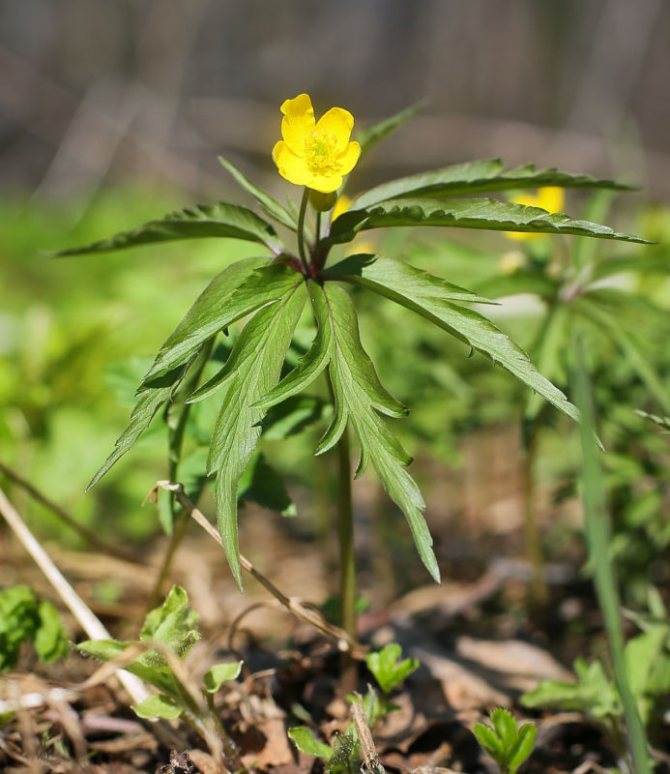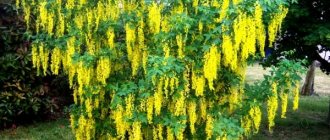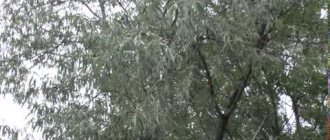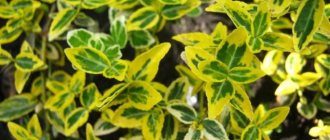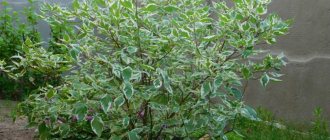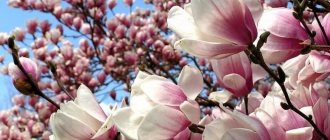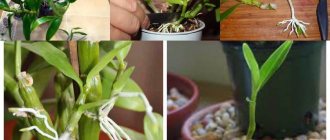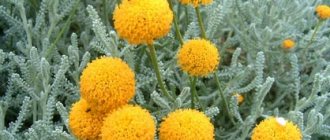Scientific name: Anemone sylvestris
Family: Buttercup (Ranunculaceae)
Life form: perennial herb
Sizes: 25 - 50 cm
Bloom time: May - June
Habitat: forest edges and clearings, light coniferous and deciduous forests, dry meadows, steppes
Anemone forest, or Anemone has a powerful vertical or oblique rhizome, with a fibrous root system. Basal leaves from 2 to 6, they are with long petioles, which are densely covered with soft long hairs. The leaf blade is dissected, also covered with hairs pressed to the surface, hairs are less frequent on top, and thicker on the bottom of the leaf.
The erect stems of the anemone are pubescent with the same hairs as on the leaf petioles; closer to the apex, the pubescence becomes especially dense. Stem leaves begin to grow above the middle of the peduncle. The plates of the stem leaves are the same in shape as those of the basal ones, but they sit on shorter petioles 1 - 2 cm long.
The flowers are large enough - from 3.5 to 7 cm in diameter. Tepals are elliptical or obovate, pure white, slightly purple on the underside and densely pubescent with appressed hairs. The yellow stamens are much shorter than the white tepals.
White flowers with yellow stamens. How cute!
Pistils are ovoid. At the end of flowering, Forest Anemone produces numerous small flattened fruits with a short nose, also equipped with white-tomentose hairs.
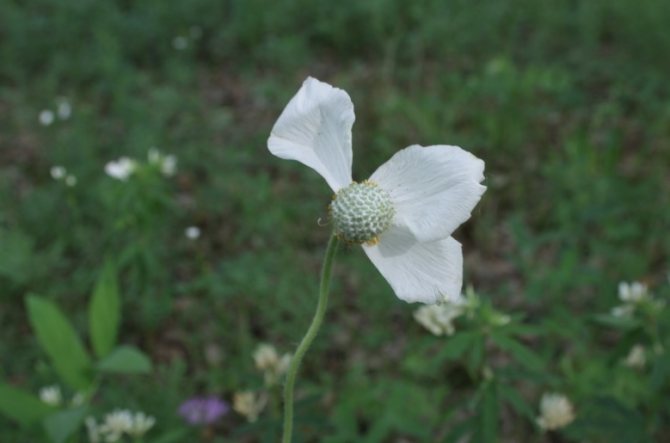
The anemone fades. Numerous fruits are already visible, still green.
Forest anemones: description with photo, use in landscape design
This type of anemone is able to decorate any flower bed. It goes well with daffodils, tulips, hydrangeas and lilacs. The anemone looks beautiful, planted near low junipers.
Forest anemone is divided into two subgroups:
- Anemone oak (Anemone nemorosa). It grows in European oak forests, forming from its thickets a low green carpet up to 25 cm high. Flowering begins in late April and lasts for 3 weeks. At this time, white flowers with a diameter of 3 cm bloom.
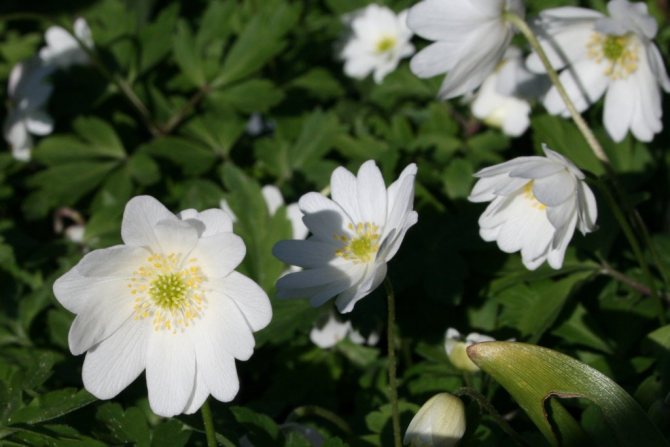

- Anemone buttercup (Anemone ranunculoides). This species of forest anemone blooms with yellow flowers throughout the week. Flowers are much smaller than the previous species, but also completely cover their bushes.
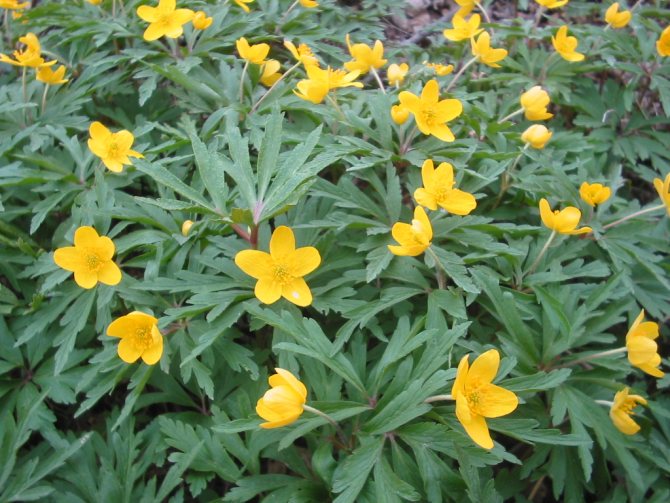

Anemone - flowers in love with the wind
After a long winter, longing for the sun and warmth, people rejoice at every green sprout. And, of course, primroses bring a lot of positive emotions - heralds of the coming spring, a symbol of hope ... As soon as the snow melts, on the edges of the meadows, under a rare canopy of the forest, as if smiling, lovely delicate flowers bloom: white, yellow, pink, blue, lilac. Amazing plants have adapted to bloom when the trees still have no foliage and every ray of sunlight reaches the land saturated with moisture.
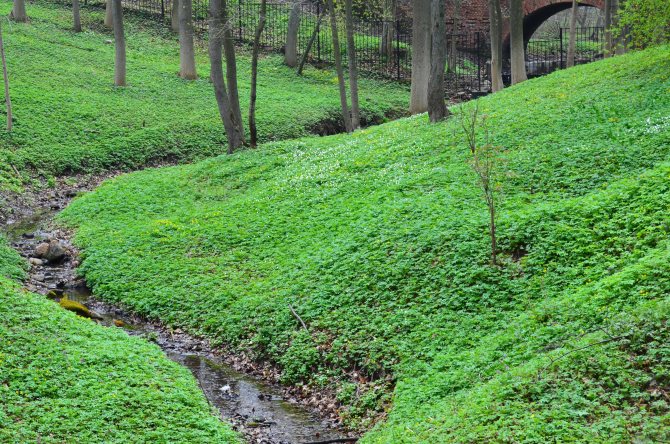

Although we do not have real snowdrops, there are a number of plants that replace snow. These include anemone... Huge glades of snow-white flowers sway from the slightest breeze. But the plants are not afraid of spring winds, as if they sway against them on long stems.Their thickets will conquer any heart with grace and beauty. The unforgettable scent of these flowers will remain in your memory for a long time. The smell of tenderness, the beginning of spring ...
Daughters of the Wind
Beauties are often windy. Such, apparently, is the law of nature. But still, why "anemones"? This is how the Latin name of the genus Anemone, given to the flower by the philosopher, sounds translated into Russian Theophrastus... It comes from the Greek word "anemos" - wind. Interestingly, in other languages, for example English, it translates as "wind flower".
And it is difficult to say why these plants are so named. Either from the fact that a little breeze blows, their rather large petals begin to perform their graceful dance, flutter, sway on thin stalks. Either it is to blame for the belief that the flowers close in the wind, as if hiding from it. Yes, it’s probably not that important.
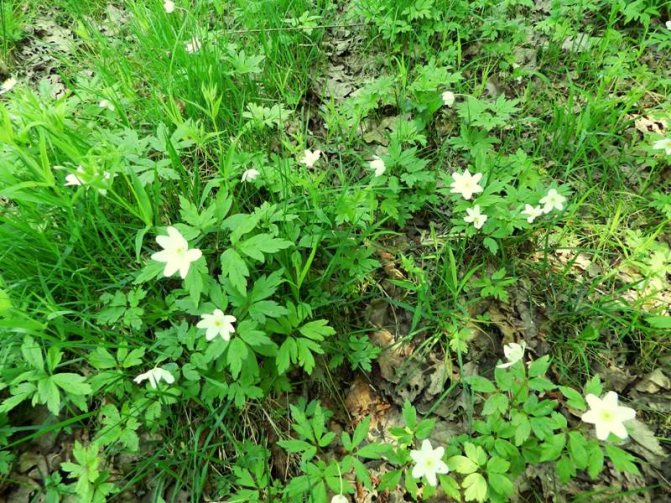

The folk (local) names of anemone are more diverse: snowdrop, freckle, white scrub-coppice, buttercup, white flowers, kurloslep (due to toxicity). There are also some very exotic names: goat growth, hemp (leaf shape like hemp-li), goat, one month old, mentor, ambirka... They are also called "the flower of Holy Friday", as anemones often bloom by Easter.
From small toe-sized bushes
By the way, the genus of anemone, or anemone, belonging to the buttercup family, is very numerous - there are about 100-160 species of herbaceous perennials (in Russia and the countries of the Near Abroad - 46-50). The numbers fluctuate due to "confusion" in taxonomy. For example, according to modern concepts, many botanists distinguish a number of generic taxa, such as the anemone (Anemonoides). Aboriginal grows in Belarus forest anemone, anemone and oak anemone.
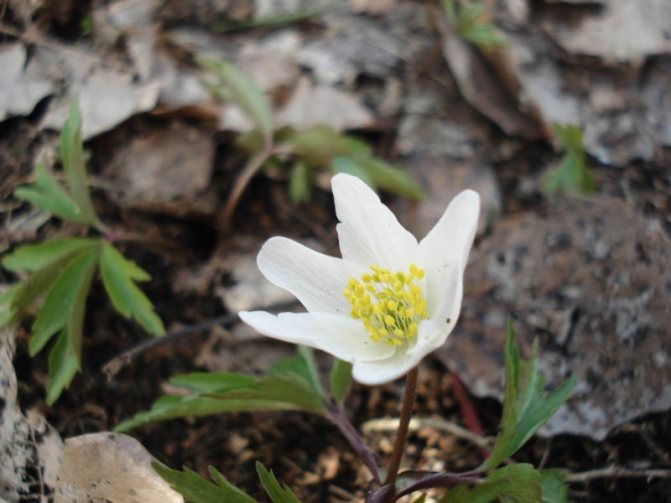

Among the anemones, there are both ground covers with a height of 7-20 cm (Richardson, Udi, Caucasian, Altai, tender), and powerful spreading bushes more than a meter (felt, cylindrical). On average, plant growth does not exceed 50 cm. There are species with rhizomes and with tubers-bulbs.
Despite the great variety, the appearance of anemone is quite characteristic. A bare or slightly pubescent (sometimes whitish-woolly) thin stem rises from the ground, occasionally with one basal leaf on a long petiole. The peduncle ends with a single (greenish, pink-yellowish, bluish) bud or inflorescence (umbrella, less often panicle). Somewhere in the middle of the stem, a whorl-ring of 3 (less often 2-5) patterned leaves is usually attached - pinnately or finger-dissected. Spread on the sides on petioles in half a leaf blade, they form a kind of cover for a flower, sometimes with thick tomentose pubescence.
Solo part, duet-trio or ensemble
Anemones bloom, as a rule, in spring when the soil warms up to + 8-10 ° C in the daytime. Usually already in April, 1-2 weeks after the snow melts, in some warm years - from late February - early March to mid-May. There are species that bloom in summer, and there are also autumn ones.
The time comes, and on the top of the peduncle, almost together with the unfolding of the leaves, a single flower begins to perform its solo part (rarely 2-3 or more) ... This spectacle, rare in beauty, is a curtain of blooming anemone: on a green background, gracefully dissected trifoliate leaves are scattered 5-6- terminal stars with a diameter of 1-8 cm. Sometimes the flowers look like a poppy or chamomile with 7-14 narrow petals, there are simple, semi-double and double types of peonies.


And the color of the petals is varied on both sides - from nondescript greenish to bright snow-white, golden, delicate pink-creamy red to rich bluish-blue and lilac-violet. A note of charm is given in the center of the flower by a disc dotted with numerous pistils and stamens (3-4 times shorter than petals): yellow, blue, black ...
Brief moments of beauty
In the evening and in bad weather, the stalk usually droops: delicate petals are sensitive to the weather, closing in frost, bad weather and at night. This way they keep the pollen from rain and dew. And on a clear day with sunrise, the flowers are wide open, exposing a fertile core for all who are thirsty for abundant sweet sticky pollen. They are clearly visible in a leafless forest, and they are eagerly visited, along the way by pollinating, beetles, thrips, flies, bees, bumblebees. Some species, such as the buttercup anemone, are pollinated by rainwater, on the surface of which pollen grains float in the perianth. Self-pollination of flowers does not occur.
Flowering of anemone often does not last long, only a few days, rarely for a month. When the green haze of foliage envelops the forests, the petals will fly around, and at the end of the pedicel, green "hedgehogs" of fruitlets will appear - a cluster of small (3 - 4.5 mm long) oval leaflets covered with thin curly hairs. Seed productivity in anemone is quite high: up to 70% of fruits are set.
Multi-roots, usually in dense fluffy clumps, can be carried by the wind, but close to the mother plant. By this time, the embryo of the seed immersed in the endosperm, although small, is fully formed. And by the end of May - beginning of June, greenish seeds, ripe, spill out of the fruit. Thanks to oily appendages, they are willingly taken away by ants, sometimes they are carried by water.
If you want to live, be able to grow
Once in favorable conditions, anemone seeds in a month and a half (in September) can germinate together... By winter, the cotyledons and 2-3 leaves of the seedling dry up, and adventitious roots appear on the reddish stalk to help the main root and the buds of renewal are laid. In the spring, a new rosette of 2-3 leaves will form from them.
However, not all types of anemone (eg smooth, buttercup) form seeds. Most often, in populations of anemone, from the beginning of the growing season to the death of aerial shoots, vegetative propagation occurs, leading to the formation of dense thickets (spots, patches). It is carried out due to the disintegration into parts of long rhizomes (sometimes thickened and with a bunch of adventitious roots) or less often due to their growth and branching. The intensity of this process depends on the number of individuals and the lightness of the soil: on average, for 3-4 years, the growth is up to 30-40 cm in diameter.
Northerners are not up to whims
And wherever anemones are found - in their historical homeland (in Southern Europe, Syria, Lebanon, Israel, Japan, North Africa and America) or in other countries (China, Northern Europe, Norway, Alaska, right up to the Arctic) - suitable for their habitat is in the temperate and subarctic belts of the Northern Hemisphere. Among them there are both inhabitants of the tundra and taiga, and open spaces. These plants prefer light pine and shady deciduous forests, bushes, forest edges, glades. But they can conquer rocky slopes, cliffs, decorate sandy hills and steppes, grow in mountain valleys and meadows.
Vitality and unpretentiousness - these are the main advantages of the "windy northerners". For "success" they need not so much: moderately moist, loose, fertile soil, be it sandy, clayey, peaty or podzolic. Although anemones love light partial shade, they grow well and bloom in open areas. As a rule, they bloom before dense foliage appears in shrub trees. But then, in the twilight of the crowns shade-loving (oak, buttercup) and shade-tolerant (Canadian, forest, hybrid) species feel great. There are lovers of the sun - drought-resistant anemone tender and crown. The latter, like the inhabitants of mountain forests (gentle, blue, rocky), prefer limestone, while the rest of the species are suitable for neutral or slightly acidic soils.But even in the absence of ideal conditions, non-capricious beauties are able to adapt to everything.
"Departure from the stage" in the high season
Despite their characteristic appearance, anemone often does not look like one another, and there is no way to describe them all - it would take a lot of pages. But still, let's try to get to know some of them, sorting them into groups.
The most numerous are ephemeroids, which bloom in early spring. These amazing plants fully justify their name, striking with an unusually fast pace of development. "Come out into the light" on the eve of spring only for a few weeks: forest species, while it is light; arctic when it gets warmer; steppe and semi-desert plants - in the presence of moisture in the soil.
Initially, a whitish sprout in the form of a hook rushes from the bud of the rhizome to the light. For safety net, it breaks through not with a vulnerable delicate top, but with the bend of a thin stalk. And now the shoot with leaves folded down reaches the surface. Immediately he straightens up, lengthens, his leaves unfold. The plant blooms almost immediately. And all thanks to the "building material" - the reserves of nutrients in the fleshy rhizome.
Spring will push up a little more - "green noise" will go through the forests. Then the anemone will put on new clothes. Not a trace of a recent smile will remain - the stem and leaves will turn yellow, turn yellow.
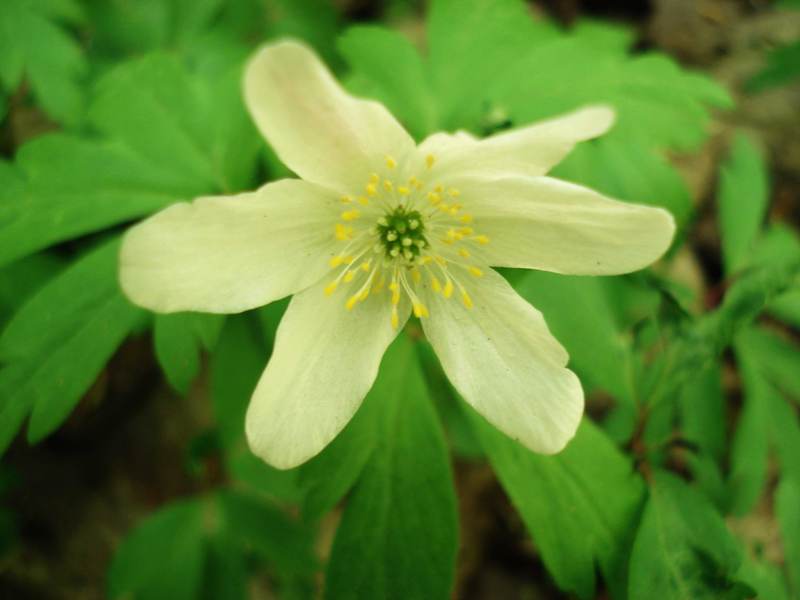

Having fulfilled their purpose: to grow, bloom and bear fruit, the plants will die off ... And at the beginning of summer, usually no traces on the soil are visible from them. They certainly won't die. They will simply leave "from the stage" to rest, disappear behind the "curtain" of the litter, hide under the ground. Until the new spring, life will lurk in a thickened rhizome.
In a word, ephemeroids have their own, special, development schedule. Being awake for a month, all the rest of the year they are in the form of a sleeping beauty, waking up from the first kiss of the sun. And so these plants are able to live for decades, most of the time in the form of a succulent rhizome, similar to a winding, knotty hook with constrictions and bunches of roots.
"Sleeping" beauties
You can meet ephemeral beauties in the light April forest, not yet clad in foliage, wide open by the spring winds. And by the fluttering of delicate white petals, it becomes clear that this oak anemone (Anemone nemorosa), or anemone oak (Anemonoides nemorosa), the most famous representative of the anemone. The oak relict, having adapted under the pressure of ice to the conditions of coniferous forests, now goes far to the north. Thickets of this species delight every year with the gracefulness of flowers - snow-white with a light pinkish-purple bloom, swaying on long (up to 30 cm) petioles.


Anemone oakravnaya
A little later, in May, he applies gilding to litter in deciduous forests anemone buttercup, or buttercup, or buttercup (A. ranunculoides). In many ways it is similar to its "windy" sister, but its flowers are smaller in size and resemble buttercups in color, being arranged one by one or 2-3 (rarely more).
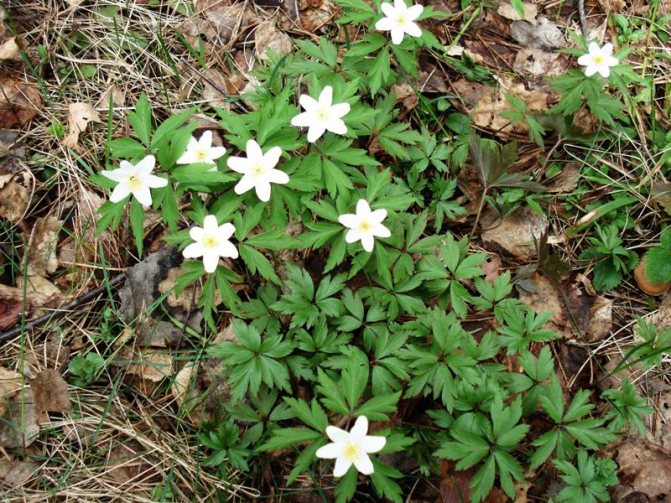

From the Polar to the South Urals pleases the eye with caps of snow-white large flowers Permian anemone (A. biarmiensis). On the banks and valleys of the Cis-Urals rivers occurs Ural anemone (A. uralensis) with characteristic white or red-pink flowers. Originally from the Sayan Mountains and the south of Western Siberia blue anemone (A. caerulea) attracts with delicate blue and white flowers surrounded by three patterned leaves.
The relic has a much wider distribution area. Altai anemone (A. altaica) - from Europe to Japan. A baby the size of a finger, opening a parade of anemone, enchants with white chamomile-shaped flowers with a purple spill up to 5 cm in diameter.In the wet forest glades of the Far East, flowers turn white in spring anemone smooth (A. glabrata). Stands apart among the Far Eastern anemones Udskaya anemone, or Udi (A. udensis). It is remarkable not only for its snow-white flowers, the shape of the leaves, but also the desire to capture new areas, forming a beautiful dense carpet up to 20 cm high.
"One is not a warrior in the field"
Many species of anemones, due to their powerful root system, are able to form thickets. This is what the twins do - american anemone canadian (A. canadensis) and a resident of the Far East - forked anemone (A. dichotoma).Plants of medium height with branching stems are spectacular throughout the season: in spring - deeply dissected leaves with fluff, in summer - whitish stars, with a blush at the bottom of the flowers, by autumn - reddening leaves. Dense light green thickets forms another Far Eastern species - flexible anemone (A. flaccida). Snow white Amur anemone (A. amurensis) prefers to live more freely, in loose coats.
A resident of light forests, meadows, steppes, mountains from southwestern Europe to Kamchatka - forest anemone (A. sylvestris) is very similar to a relative from the oak groves, but taller - up to half a meter. And its stem is densely pubescent at the top. The Red Book of Belarus blooms a little later than her sister - from mid-May, the leaves remain green until October. And her flowers are larger (up to 7 cm), slightly drooping, pale lilac below. So they shine with five-pointed white stars with a yellow center.
Tubers are more reliable than roots
There is a group of anemones - owners of potato-type tubers instead of rhizomes. The lifespan of their aboveground part, like that of ephemeroids, is short. The most famous of them tender anemone (A. blanda) thanks to the bluish-lilac with a yellow disc in the center, chamomile flowers up to 3 cm in diameter.Roropyzhka from the Ciscaucasia and the Balkans, although it didn’t come out in height, is half the size of its oakwood relatives, but together forms dense curtains and blooms before anyone else - in February -March.
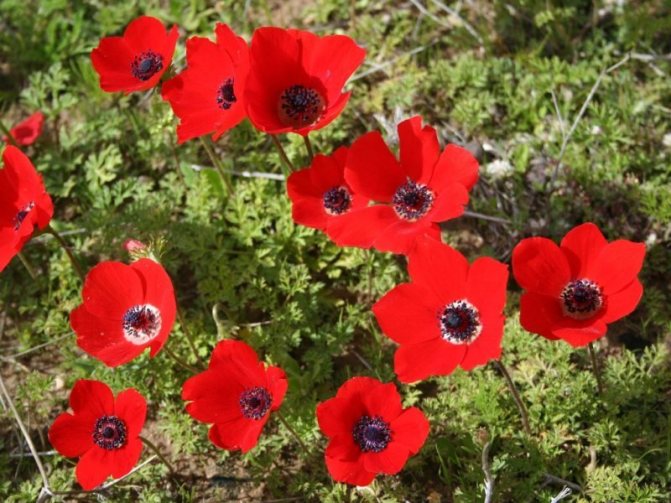

Anemone crown. Photo: wikipedia.org
Probably one of the most magnificent representatives of this genus is the inhabitant of the deciduous forests of the Mediterranean, Asia Minor and Africa - crown anemone or crowned (A. coronaria). And this queen loves to be capricious. True, if there is enough heat moisture, it can delight for a long time with large simple or double flowers of different colors: from white-pink to blue and scarlet, like poppies have blossomed. And in the center of them are bunches of numerous dark stamens. It is impossible not to pay attention to the glittering anemone (A. fulgens). This miniature plant, being a natural hybrid of garden and peacock anemones, grows in meadows and olive groves in France and Spain. Its bright red flowers with a bluish-white disc with black stamens are sometimes collected in semi-umbrellas, often semi-double and double.
From spring to autumn
Among the anemones there are species that delight the eye all summer with numerous flowers collected in an umbrella inflorescence. These are stately beauties: the long-haired anemone (A. crinita) - a Siberian woman with large leaves and white flowers, and the daffodil anemone (A. fasciculata L = A. narcissiflora), growing in the mountains of Europe, Asia, North America at an altitude of 2.5 km ... The leaves with the fluff of the latter and the snow-white caps of flowers with golden polka dots, toasted from below, are spectacular. It unites many subspecies, differing in height, the number of flowers in the inflorescence, their size and color.
And in the beautiful multi-cut anemone (A. multifida), living in crevices of rocks, having a wide habitat and combining several very close species, splitting can occur within the population according to plant height (from 5 to 50 cm), flowering time and petal color - from white-yellow-cream to red-violet shades.
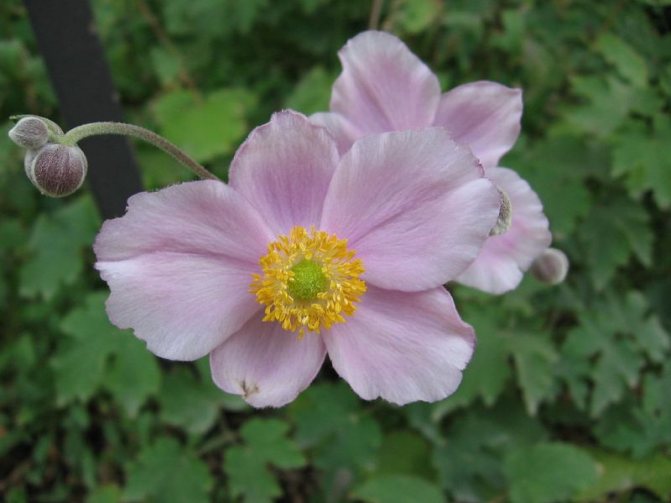

Hybrid anemone. Photo: wikipedia.org
I would like to mention hybrid anemone (A. hybrida). These are, as a rule, spectacular garden forms, the parents of which are similar types of anemone: Hubei (A. hupehensis), grape-leaved (A. vitifolia), japanese (A. japonica), felted (A. tomentosa), etc. By the way, the latter species is the most cold-resistant and hardy among this group of autumn anemones blooming in August-September. Tall, up to one and a half meters, the plants are crowned with a loose umbrella of 10-15 large white, pale pink or cherry-burgundy flowers.Expanding quickly, the hybrids form an openwork cover of gray-green color.
Parade of "windy" beauties
Among the anemones, there are many plants that deserve a separate discussion. For example, moisture-loving Virginia anemone (A. virginiana). A tall plant with rounded toe-leaves and white panicles, it even tolerates temporary flooding. Wide open white flowers, collected in umbrellas of 10-20 pieces, look very impressive against the background of deeply cut pubescent leaves, another lover of moisture - handrail anemone (A. rivularis). From below, they cast the blue of metal, and inside them, bundles of bright blue stamens sparkle. Anemone cylindrical (A. cylindrica) does not amaze with the beauty of flowers whitish with greenery, but attracts with silvery, downy bolls swinging on long (up to 120 cm) peduncles.
Many original species are found in the mountains. Spherical anemone (A. globosa) strikes with a palette of flowers - from greenish yellow to dark purple. Unpretentious rock anemone (A. rupestris), a resident of the Himalayas captivates with purple peduncles with three large snow-white flowers filled with purple ink below. The anemone Drumoda (A. drummondii) climbed even higher, up to 3.7 km above sea level - its white flowers below with a greenish, blue or lavender spill.
Little anemones are also adorable. In March-April, red-brown buds spring anemone (A. eranthoides) are transformed into tiny creamy yellow daisy-like flower twins. Small in stature and very rare, resembling a tiny lumbago, multi-headed anemone (A. multiceps). In the mountainous damp forests, thickets and meadows of Alaska, another mini-plant grows - the yellow-eyed Richardson's anemone (A. Richardsonii).
The healer is not for everyone
Despite the fact that anemones, due to their toxicity due to the anemonine alkaloid contained in their parts, cause redness of the skin, irritation of the eyes and other mucous membranes, this does not detract from their medicinal properties. They contain a number of useful substances: saponins, vitamin C, tannins, resins, chelidonic acid ... And although in official medicine these plants, in particular anemone, were supplanted by stronger drugs, they are very fond of traditional healers.
For medicinal purposes, they mainly use leaves (often fresh), less often roots as a remedy in the treatment of many diseases, often in a mixture with other herbs. Infusions enhance the activity of the kidneys and lungsthey are appointed for oncology, male and female diseases... With their help you can treat headaches and toothaches, neuralgia, vision and hearing. Possible positive effect with gastrointestinal disorders, paralysis. Have a good healing effect with eczema and purulent wounds... Alcohol lotions made from leaves or roots are effective with gout, rheumatism, radiculitis, edema, dermatoses.
Love does not love…
Our ancestors believed that anemone flowers attached to clothes protect a person not only from disease, but also from harm. The wife's dried white petals were used as a talisman so that husbands would not walk. And these plants, placed in the bedroom or painted, embroidered, allegedly strengthened the relationship of the spouses. There were many original love spells. And in order to get married as soon as possible, rural beauties in white "windy" wreaths looked on the river bank, as in a mirror, into the water, imagining themselves in a wedding dress and a veil.
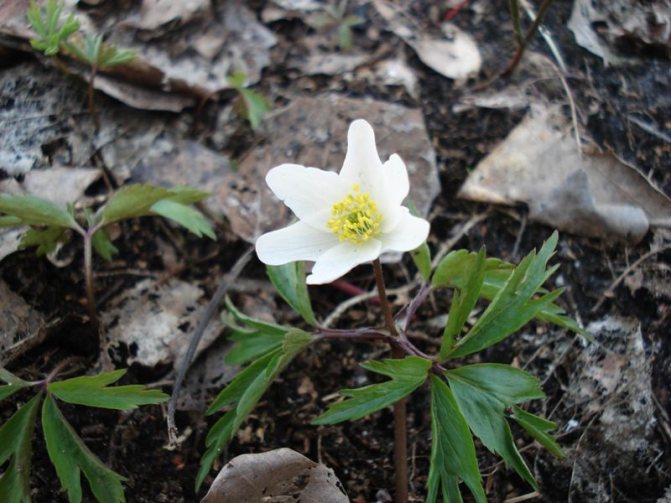

They loved to use the anemone and tell fortunes. If the petals of a plucked flower, when it is slightly shaken, fly around, then, alas, the plan will not come true. If they stay, they guess by them: it will come true - it will not come true. By the way, if a white flower dreams in a dream, changes for the better await you; if the petals are yellow, look around - if there is a rival-love-lover nearby; an anemone with pinkish petals foreshadows good children, and a whole bunch of these flowers - a long, happy life in marriage.
Popular decorator gardener
For the first time, anemones began to be grown in the gardens of Japan and China in the 16th century. Since the end of the 17th century, their varieties have moved to Europe. And now for several centuries the anemone, as it has long been called in Russia, captivates gardeners with tenderness and beauty, gaining immense popularity.Anemones look like a picturesque carpet not only under oak-pines in the clearings, but also touchingly look in young grass among fruit trees, on the outskirts of shrub thickets, against the background of tender spring foliage of dwarf barberries and spirits. As a decoration of flower beds, sparkling islets of anemone are good between tulips or primroses, among pansies, scillas, poppies, peonies, phlox, capable of disguising their leaves that are withered by autumn. Tall anemones are not lost in autumn compositions against the background of grasses. They are used not only in flower beds, borders, rock gardens, they are planted on lawns, they are suitable for cutting and for free compositions.
First of all, the hands of breeders touched the oak tree anemone and from a shy woman it turned into a real miracle. Unpretentious white flowers have transformed into something unusual. The range of varieties is not so great (several dozen), but each flower is unique: there are outgrowths instead of stamens, and some have even turned into one huge green boil. Interesting garden forms with large, double and semi-double flowers, with green bracts instead of atrophied petals. But the colors of the "windy" anemones are especially rich.
In addition to snow-white flowers, there are flowers with pink, yellow, red, lilac-blue, blue and purple hues; with a middle like a "white explosion" or in the form of green leaves, like a flower in a flower. There are varieties with leaves instead of petals, similar to an openwork green bush; with white ribbons-petals, shaded with green, like a play of sun and shadow; with a combination of pink and green tones. The list of varieties is replenished from year to year: breeders delight us with something, and sometimes nature surprises with its quirkiness.
Freedom is the key to longevity
For many plants, man's love for flowers turned in a sad way. Little by little, there are fewer of them, especially near large cities. Some species are already under threat. The anemones, one might say, were also unlucky. Guilty of this, their delicate, charming in their simplicity flowers mercilessly tear in the spring. And no matter what is written about the medicinal value and toxicity of anemone, they are collected to put a beautiful bouquet at home! Or, even worse, for sale: the more willingly they buy them, rejoicing in the first flowers.
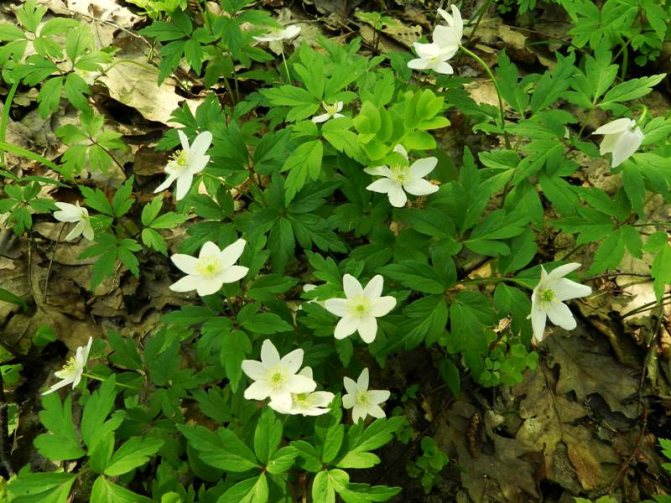

But botanists look at such "poaching" with sadness. They know well that every plucked flower is a destroyed plant. These are the features of anemone: they are very vulnerable and easily injured, despite their active life position. Pull a little harder - and you will pull out all the plants from the ground, along with the rhizome. And even if you cut off a shoot with a flower, the plant can also die. But usually one flower or a bunch is not limited to - almost the entire curtain perishes. Without even having time to stock up on nutrients and leave seeds: they cut off the flowering plants! And the young, newly grown, will bloom only after 10 years!
Perhaps, while walking through the spring forest, you will be lucky - you will come across blooming oak or buttercup anemone! After all, meeting with them, not to mention their forest sister, is always a small holiday: in some places these beauties have become quite rare inhabitants of our forests. Therefore, before you rip them, remember their uniqueness and poisonousness. And in general, it is better not to touch the spring flowers: they are more beautiful in their natural environment: in the hands of the sissy they quickly wither.
And for beauty, fortune telling, magic, perhaps it is worth planting varietal anemones near the house. And they will delight you with a variety of shapes and colors for many years in a row. And the "savages" have a place in the forest! And this will give them a chance to delight not only us, but also future generations with their amazing beauty every spring.
Figures and facts:
- Anemones, as representatives of the buttercup family, are close relatives not only of buttercup, but also of peony, delphinium, clematis, lumbago (sleep-grass), liverwort.
- Have you noticed that in the second half of May, the golden color dominates in nature? Apparently, its warmth, to match the sun's rays, is more attractive to pollinating insects. Such are the mother-and-stepmother, dandelion, swimsuit, cleanser, buttercup anemone. Later, the yellowness in flowering grasses becomes less.
- Although the flowers of the buttercup anemone resemble buttercups, firstly, they are larger (up to 3 cm in diameter), and their perianth is simple: it consists only of golden petals. In the buttercup, it is double: there are also green sepals.
- It turns out that the anemone plant that has grown from seeds blooms only at the age of 10. And the rejuvenated offspring, which have re-emerged on the roots of adults, turn to flowering only after several years of vegetation.
- A separate anemone flower flaunts on the stem for 6-15 days, rarely 3-4 weeks. The life cycle of a bush before its decay lasts several decades (20-50), half of it falls on the generative period.
- There are many legends about the origin of the anemone. According to Greek mythology, they appeared from the tears of the goddess of love and beauty Aphrodite... According to another, from the blood of her beloved Adonis... Someone is closer to the tradition of their creation by God in the consolation of our foremother Eve, expelled from paradise, from the flakes of snow falling on her shoulders. However, myths reflect only the transience of life of anemone in nature, but not on earth, because these plants have been known since the pre-glacial period.
- Many of the anemones - rare protected plants! Anemone oak, Baikal, Kuznetsova and a number of others are listed in the Red Book of Russia, in the Red Data Books of a number of European countries. Forest anemone - a relic of Belarus, Latvia, Poland, Russia. Buttercup anemone has not yet received such an "honor" - apparently, its position does not inspire fears yet. But it is also included in the lists of protected plants in a number of regions of Russia.
- Among the anemones there are completely exotic - rare species, belonging, however, to other genera. For example, the only representative of the genus Anemonella is the North American "little anemone" (A. thalictroides). The varieties obtained from it are bred as houseplants. Another exotic, the Japanese false anemone, also has its own genus, Anemonopsis. In Europe, this plant, which blooms at the end of summer with luxurious flowers, pulling off flexible thin stems up to 80 cm in length, is practically unknown.
Recipes
- 2 tsp dry chopped herb of anemone pour 1 glass of cold boiled water. Insist 20 hours, drain. Take the infusion in 2 tbsp. l. 3 times a day for the treatment of heart and broncho-pulmonary diseases, fever, migraine, stomach pain, problems in men and women; in the form of compresses (rheumatism, gout), lotions and washings (dermatoses, purulent wounds).
- Pour 10 g of fresh or 2 g of dry crushed anemone leaves with a glass of cold boiled water. Insist for a day. Or, pour a glass of boiling water, insist 4 hours in a thermos. Strain, squeeze out. Drink the extract in 20 minutes. 3-5 sips before meals during the day with inflammation of the liver, spleen, kidneys, gallbladder and bladder.
- Boil 1.5-3 g of root shoots of anemone in a glass of water. Use for rheumatic and joint pain.
- 100 g of chopped dry herb of anemone pour 1 liter of alcohol (vodka). Place in a dark place for 7-10 days, shaking occasionally. Strain. Use the tincture internally and externally (for rubbing) for joint pain.
Be careful!
Although anemone and healing, they are poisonous and in the language of flowers "anemone" means fragility, disease... Therefore, they should be used with caution and an overdose of drugs is unacceptable. Treatment is contraindicated during pregnancy and lactation, with cardiovascular diseases, inflammation of the kidneys and gastrointestinal tract.
Before using infusions and extracts from it, be sure to consult with a herbalist. If someone close to you or someone you know is poisoned by this plant, immediately induce the victim to vomit. Then drip Corvalol for him and call an ambulance.
Photo by the author
Share on social media networks:
Previous Next
Landing in open ground
Taking into account the peculiarities of growth in the natural environment, the forest terry anemone must be planted so that it quickly adapts and goes into growth. That is, the place should be covered from cold northerly winds, it should be in the shade, moisture should not accumulate in the place where the anemone grows.
The place has been chosen, the next step is to prepare the soil for planting the plant. If the soil is poor on the site, then in the fall, when digging, manure is introduced or in the spring, but only rotted manure or earth from the compost heap. The soil should be loose enough to allow oxygen to flow to the root system of the bushes. Therefore, if there is black soil on the site, then peat is added to the flower bed to lighten the soil.


IMPORTANT! If the garden area is often swamped, then a high bed with a good drainage base is arranged for the anemone bushes. In this case, the roots will not be constantly soaked in melt or rainwater.
Forest anemone transplantation technique:
- As soon as the green noses of young shoots appear from the ground in the spring, the bush is dug out of the ground with a pitchfork and transferred to a new place of residence.
- A bush is placed in a hole dug out by the size of the root mass, the earth is poured, and it is well spilled with warm water.
- After planting a bush, it must be well mulched with dry grass.
IMPORTANT! If the air temperature is high and the weather is sunny, then the landing should be shaded from hot sunlight.
Types and varieties, their shades
First of all, the crown anemone deserves attention. The development of this plant is very fast. Leaf release begins as early as possible. Leaves of a complex structure are placed on petioles and folded into rosettes. In the crown species, medium-sized seeds appear, covered with short fluffs.
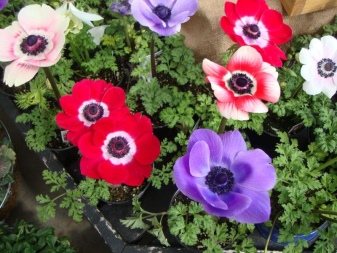

The Udskaya variety is widespread in nature in the Primorsky Territory of the Russian Federation. Flowering occurs in May and partly in June. The Hubei (Hubei) anemone also has attractive features. The plant blooms in autumn, its habitat is east Asia, including Japan. Strong stems up to 1.5 m long are formed.
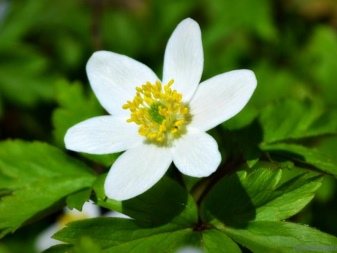

A characteristic feature of the Khubei plant is creeping rhizomes. The petals surrounding the inflorescence are hidden from external view by sepals. This delicate variety comes from the Caucasus region. In nature, it also inhabits the Balkan and Asia Minor regions. Delicate anemones reach 0.15 m in height, their rhizome resembles a thickened tuber.
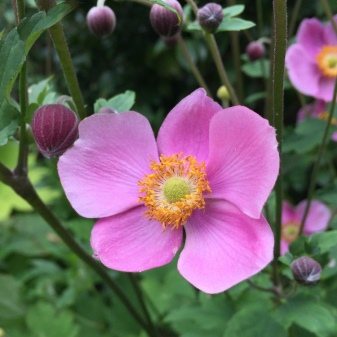

Flexible view - relatively low (up to 0.2-0.3 m maximum) culture. It should be borne in mind that the growth of peduncles occurs during the entire flowering... The appearance of thin (up to 1.5 mm) adventitious roots is characteristic. Flexible anemone can be found in the forest along with willow, alder.
Care
In order for the plant to develop correctly, it must be provided with proper care. The main criterion for care is timely watering with settled water and the removal of weeds, which clogs the planting of flowers. Loosening of the soil after irrigation is also carried out. This is done to remove any crust on the soil that keeps air out of the root mass of the anemone. The plant is responsive to the introduction of complex fertilizers. But you don't need to overfeed the plant, because instead of beautiful flowers we can get just a green mass without buds.
No pruning is necessary. After flowering, the bushes themselves throw off the foliage, but it is necessary to water it throughout the summer season. Because in a severe drought, the roots may die and then the bush will not be restored in the spring.
For the winter, they do not dig it out and only cover it with spruce branches or foliage that protects the rhizome from freezing.
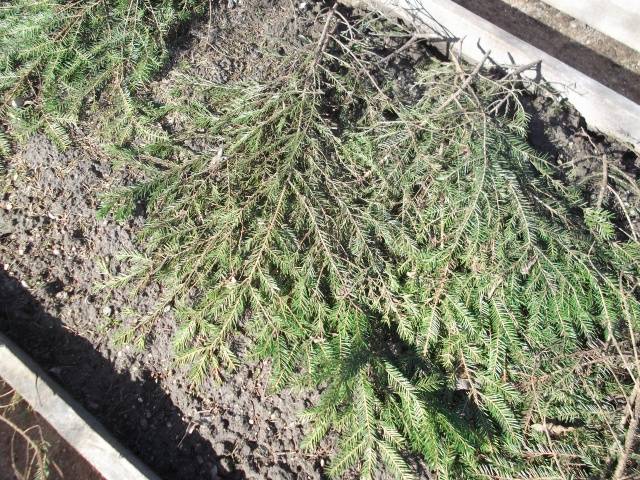

Shelter foot
Description
Anemone is not just one species, but a whole genus of perennial herbaceous plants. Crops are included in the buttercup family, and there are about 170 varieties in the group of interest. It should be borne in mind that some biologists consider some of the types of anemones to be related to the genus of lumbago. The plant is found in the northern hemisphere, its range even covers the arctic regions. But in tropical areas it is impossible to meet an anemone.
The Latin name of the genus comes from the ancient Greek word "wind". Some philologists believe that, given the nuances of meaning, an accurate translation will sound like "daughter of the winds" or something like that. In Russian, anemone is called anemone or chickenpox. Susceptibility to the wind is very high: even with weak gusts, the petals can flutter, and the flowers themselves will sway on oblong peduncles. In the past, it was even believed that the buds of anemones are able to open and close depending on the action of the wind.
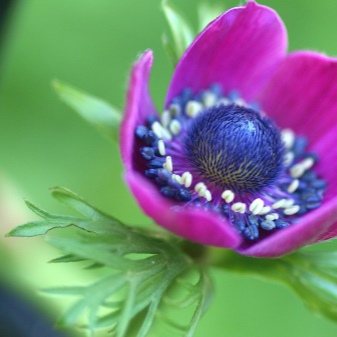

Now this opinion has been refuted. A characteristic feature of the plant is the fleshiness of the rhizome, which has the shape of a cylinder or a tuber. Terminal stems and peduncles usually appear. Only occasionally do they form in the leaf axils. Occasionally there are plants that do not have root leaves.
In most cases, the leaf is of the finger-dissected or split type. Along with single flowers, semi-umbellate inflorescences are sometimes found.
There are both small and large flowers. The shape of the perianths is very different. There are always a lot of stamens and pistils; leaf covers are practically reduced.
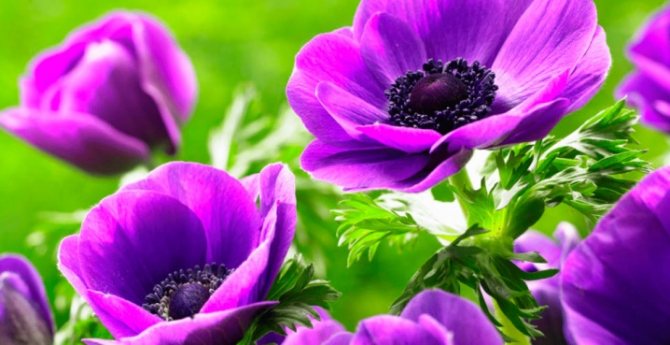

The fruits of anemones are similar to a nut, among them there are naked or covered with fluff. Fruits are often found with structures that facilitate wind movement. In the CIS, there are approximately 50 species of anemone. Perennial anemones inhabit:
- deciduous forests;
- thickets of bushes;
- shaded lawns;
- wet valleys and grassy slopes in the mountains;
- meadows in degree;
- tundra.
In landscape design, anemone is often used to frame water bodies. The culture is resistant even to a fairly severe frost. Most often, flowering occurs during the spring months. The color of the inflorescences can vary greatly, which gives the plant its charm. Anemone roots grow strictly vertically, they are distinguished by significant mechanical strength.
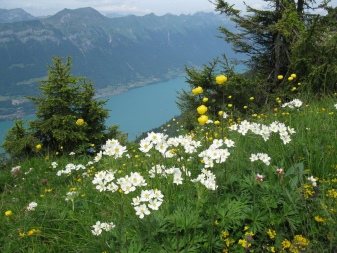

Reproduction
Forest anemone can be propagated by seeds, or by dividing the bush during transplantation. The first method is used quite rarely, since the seeds have a low germination capacity and, at the same time, varietal characteristics are not preserved. But at the same time, self-seeding often occurs, and young bushes grow next to the mother plant. Here they can be planted without much damage to the adult plant.
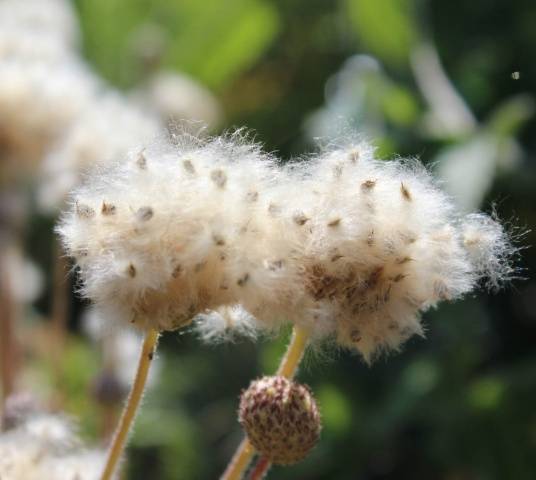

Seeds
Cuttings are carried out in early spring, when the spouts of future branches are just sprouting. The bush is dug up and shaken off the ground. After that, the sharp sector is divided into parts, which will have their own root system and growth buds. With the produced spring propagation, 65% of the cuttings take root.
About the plant
The anemone reaches 20 cm in height. The flower is kept on a straight stem.
The leaves are composed of 3 parts. Most often, there is 1 white flower on the stem, but there are flowers with light lilac or pink shades. They have 6 petals.
Anemones bloom from April to May. By June, a box with seeds grows. There are many of them.
Today, gardeners grow oak anemone in their gardens. Breeders have bred different varieties.
There are even double or half double flowers. Their buds are blue, purple, and there are also red ones. The main thing is to take good care of the flowers and they will bloom in the flower bed for 2-3 years after planting.
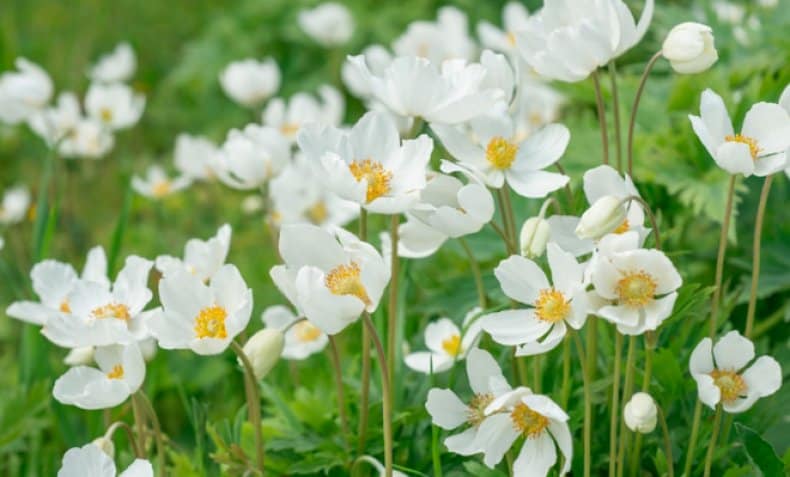

The root color system develops horizontally.Over time, other flowers grow nearby. If people do not pick flowers, then they grow in glades. In the first decade of the year, those parts of the plant that grow on top dry up.
Healing properties
All types of anemones are very poisonous and the plant is not used for pharmacological purposes. But some use it, preparing medicines according to folk recipes. But this does not take into account its toxicity. Therefore, before preparing decoctions, you need to consult with your doctor and only then start treating your body with the help of folk methods.
The forest anemone is listed in the Red Book, since thanks to humans it is almost impossible to find it in the wild.
You can buy forest anemone at the flower market of the city or in the corresponding stores.
Choosing a landing site
Many gardeners are attracted by both the beauty and the early flowering of the anemones. Therefore, they willingly plant it in flower beds.


The plant is perennial and once, having got an anemone in the garden, he will enjoy its flowering up to 10 years. These flowers are poisonous, therefore bugs and other pests avoid them. It is best to grow seedlings in the garden, in the partial shade that trees give.
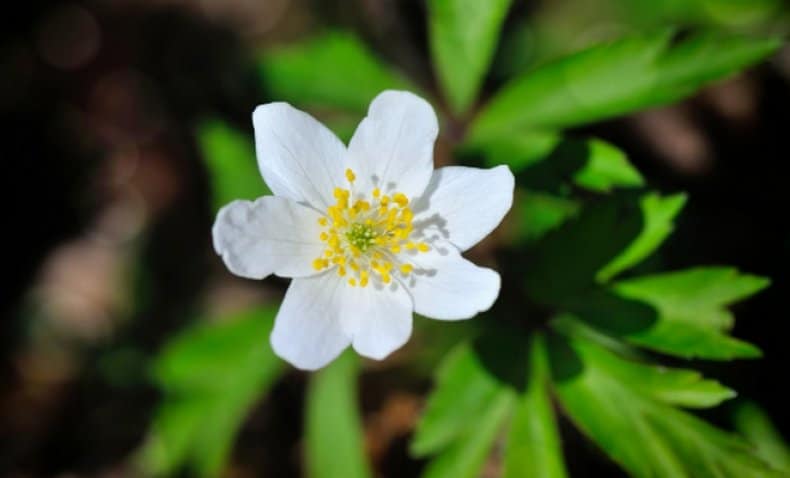

Plants grow excellently on the ground, in which there is a lot of humus and sand. It is important to water the flowers well during the entire flowering period and continue watering even when the upper part wilts. The owner must periodically loosen the ground by 1 cm so that a crust does not form and in the fall apply manure and mineral fertilizers.
Breeding features
Although the anemone cannot be called capricious, it is recommended to observe a number of simple requirements for its successful breeding:
- A perennial is very susceptible to sunlight. When choosing a site for planting, you should pay attention to the fact that there is enough light on the site;
- Perennial is also demanding for the characteristics of the soil, it is recommended to plant it in sandy soil;
- When artificially growing melliferous plants, you should not wait for flowering during the first year of life, it does not come before 2-3 years of breeding.
Although the perennial loves warm sunlight, it is better to choose a place in the shade for planting, so you can protect it from the scorching sun. In gardens, areas under the spreading crowns of fruit trees will be an ideal place for breeding. The shadow from the foliage will provide a soft and diffused light, which has a beneficial effect on the delicate flower.
general information
The genus anemone (anemone) belongs to the buttercup family. From Greek "anemos" is translated as "wind". This genus includes several plants that are medicinal and, although rarely, are used in folk medicine:
- forest anemone;
- Altai anemone;
- Baikal anemone;
- oak anemone;
- buttercup or buttercup anemone.
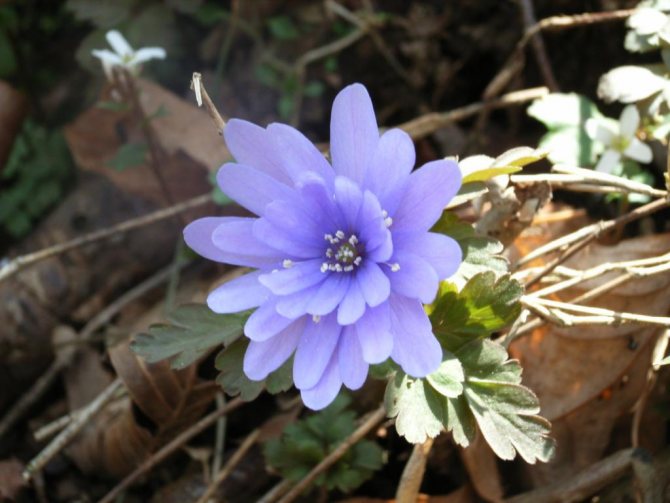

Their common name is anemone or botanical anemone. In order to obtain medicinal fees, only the ground part of the plant is used, since the rhizome has many toxic substances, alkaloids.
All plants belonging to this genus must not be eaten. In addition, fresh juice on contact with the skin can cause an allergic reaction, flushing. The affected area begins to redden and swell.
The plant should only be used as an emergency and as an external agent. It is noted that the toxic properties are slightly reduced after the harvested greens are dried.
Anemone is widely used and cultivated to decorate gardens. Ornamental varieties are especially good, for example, crown anemone.
A description of the forest anemone is presented below in the article. And first, let's imagine the spring and autumn conditional groups of anemones.
Among the wide variety of varieties, there are both unpretentious and requiring any special care. This feature is explained by the fact that anemones represent two categories of plants - rhizome and tuberous. The first are unpretentious and calmly reacting to the shortcomings of conditions and care.Representatives of the second category do not tolerate any deviations in care.
Contraindications
The forest anemone, in comparison with other members of the family, has the least amount of toxic substances. But it should be remembered that with improper collection and incorrect preparation of raw materials, poisoning can develop. The use of the plant can cause the following consequences:
- cramps, trembling hands, contraction of smooth muscles;
- shortness of breath or shallow and rapid breathing;
- flickering of black dots in front of the eyes, spasm of the muscles of the eye, and at high doses, blindness may develop;
- tinnitus, hearing impairment;
- diarrhea, vomiting, complications in the gastrointestinal tract, bleeding is also possible;
- the appearance of blood in the urine in the presence of kidney disease;
- the appearance of redness, swelling, itching and rash when the juice of anemone comes into contact with the skin.
There are no documented fatal poisonings. But in patients with vascular and heart disease, under the influence of alkaloids, heart attacks or respiratory failure may occur.
Combination in a flowerbed with other plants
Among the flowers, there are individuals with similar and dissimilar habits. If you place plants in the same flower bed, then you need to select them so that they have the same requirements for light and humidity.
IMPORTANT! (click to find out)
The anemone behaves quite aggressively with other representatives, as it sucks out all the nutrients necessary for growth from the soil. Moreover, it is this family that can poison the lives of other green "brothers".
But, nevertheless, bulbous and ground cover crops can be on the same flowerbed with an anemone. Lily of the valley, fern, liverwort, chrysanthemums, vervains can be found next to the anemone.
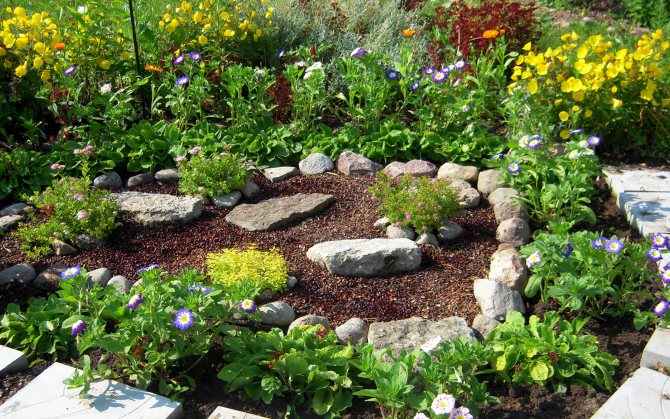

Colorful flower bed with anemone
Using anemones
Anemones are most often used when drawing up any landscape compositions in the garden. To compose the composition, you need to take into account the type of anemone.
For example, the Altai type of anemones perfectly tolerates the shade, begins to bloom in early spring. That is why it will look great in the near-trunk circles of trees and small shrubs.
Crowned anemone is very fond of the sun, blooms in early spring. You can add tulips to this look and it will turn out very beautifully.
In most cases, stunted anemones are grown along the edges of the path between trees. It is better to plant buttercup and oak anemone here.
You can endlessly fantasize with these types of plants, which is why all gardeners love them so much. Plus, the flowers are full of a variety of colors.
Anemone transplant
Since the anemone grows over time on the site, it can oppress other plants planted nearby. Transplanting an anemone will help to solve the problem.
It is best to carry out the procedure in the spring when the first shoots appear. The roots and adventitious buds are transferred to the desired place. You can transplant an anemone in September, but in this case, the plant takes root worse.
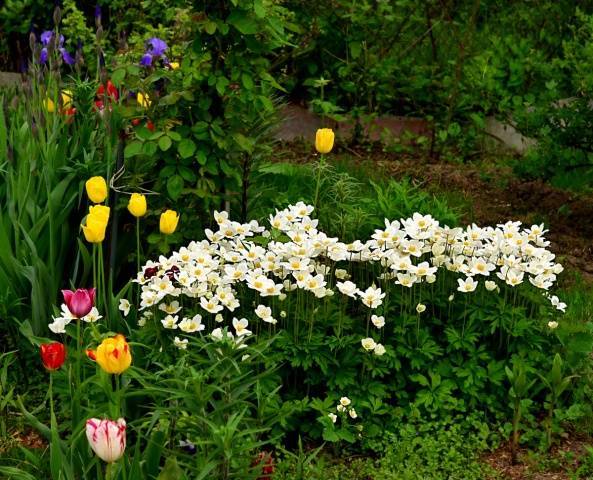

It is not recommended to transplant anemones too often, since the plant reacts sharply to such changes. The transplanted anemone may die.
Harvesting grass
For anemone to help you heal, you need to know when to pick it. At different times of flowering, flowers are filled with useful substances.
RECOMMENDATION! (click to find out)
It is not recommended to do this on your own, as only experienced herbalists know when to harvest this herb.
It is better to collect anemone in clear and dry weather. Cut off the stems together with the leaves and flowers, preferably whole. Dry the grass in the shade or use a dryer. After drying, it is necessary to pour the anemone into glass jars. Shelf life 1 year.
Contraindications
In addition to positive effects on the body, the plant also has a number of contraindications. It is forbidden to use decoctions of anemone:
- pregnant women, as the herb can provoke an abortion;
- taken by people with kidney disease, because it is this organ that removes all toxic substances from the body;
- for children under 3 years of age.
When treating with tincture of anemone, the dosage indicated by the phytotherapist must be observed.
In case of the slightest poisoning, you should consult a doctor.
But in most cases, taking as directed by the doctor, the treatment goes without any consequences.
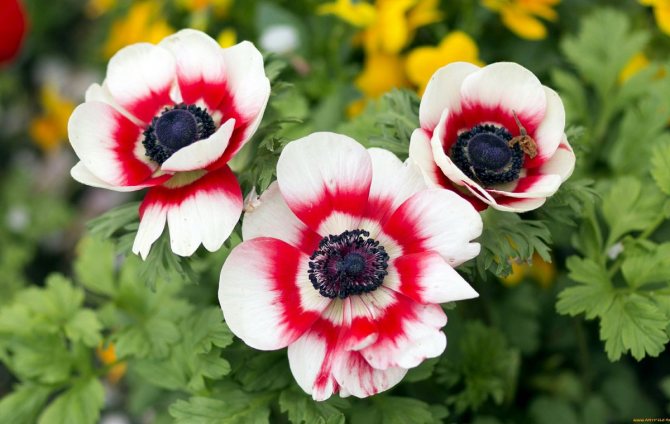

Treatment with anemone has contraindications
Planting methods for Anemone
Anemone can be propagated vegetatively and by seeds. Sowing seeds in the ground is carried out in autumn or early spring. However, it must be remembered that seed germination is low and will require a lot of effort from you. Before sowing seeds, it is necessary to stratify for 2 months. The seeds are mixed with peat or coarse sand at the rate of 3 parts of sand 1 part of seeds. The mixture should be wet constantly until the seeds begin to swell. After that, the planting material is mixed with a small amount of the substrate, moistened and placed in a well-ventilated place with an air temperature of no more than 5 ° C. When the seeds germinate, the container with the seeds is buried in the ground, sprinkled with sawdust.
Attention! Stratification is mandatory if the seed is sown in spring. If the seeds are sown in the fall, then this procedure is not required, as it will happen by itself, since the seeds remain in the ground for the winter.
The vegetative reproduction method includes the following procedures:
- Division of the root system. This method is suitable for varieties of Anemone that are distinguished by their long roots. As a rule, these are plants 3-4 years old. Division is carried out after flowering is complete. The root is divided into segments, which are planted obliquely into the grooves to a depth of 5 cm. The interval between the “divisions” should be at least 15 cm.
- Root offspring. Held in early spring. The offspring are obtained from the kidney appendages.
- Reproduction by tubers. It can be carried out in autumn and spring. Before planting, the tubers must be placed in water for several hours, preferably overnight. Swollen tubers will sprout faster. The tubers are placed one at a time in pre-prepared holes with a diameter of 40 cm, at the bottom of which a mixture is added, consisting of nutrient soil, a glass of ash and a small amount of humus. The tuber is placed in such a way that it was turned to the bottom of the hole with its lateral side or a sharp end. Embedding depth - 5 cm. After that, the hole is sprinkled with nutritious soil, lightly pressed down with a palm and spilled with water at room temperature. So that the earth does not dry out, weeds do not actively grow, it is advisable to mulch the soil.
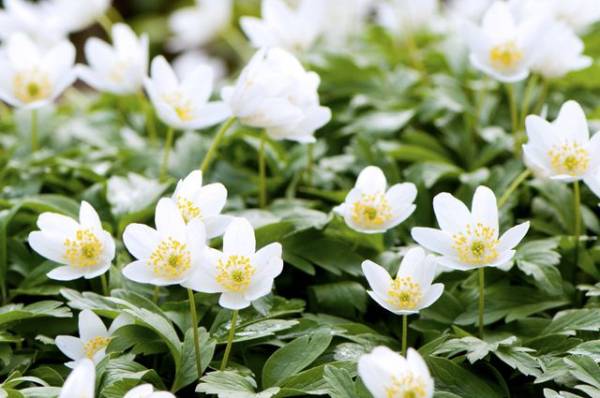

The anemone begins to bloom in early spring
A little about useful properties
Each plant brings certain benefits, the forest anemone is a real gift, it is considered one of the best honey plants. Despite the short flowering period, it fully produces the required amount of pollen. Do not forget about the undoubted medicinal benefits of perennials. Anemone is widely used in the production of pharmaceuticals.
Self-production of flower-based medicines is not recommended due to the pronounced poisonous properties of the plant. It is strictly forbidden to eat anemone, which can cause a severe allergic reaction and lead to serious consequences.
The possibility of artificial cultivation
With its fragile and graceful appearance, anemone attracts the attention of many gardeners. The anemone flower has an unusual, natural beauty. Artificial breeding is promoted by its unpretentiousness, durability and long flowering.
Undoubtedly, it is the anemone that will become a real decoration of the garden in early spring.During the period when other plants are still in hibernation, forest anemone pleases the eye with beautiful white flowers, as if floating in streams of wind. She practically does not need special care. Subject to the observance of all its aspects, the anemone will delight the eye with unusual flowering for more than a dozen years. Poisonous properties only play into the hands of gardeners, insect pests will bypass it. She is practically not susceptible to disease.
Definition formula
Genus:
The flowering stem is leafless except for the 3-leaf whorl, collected in the middle of the stem - the basal leaves are whole, strongly dissected
(there is clearly an error in terminology, because the sheet is NOT integral, it is dissected; it is possible that here the author wanted to convey the idea that the sheet is NOT complex, but simple, albeit dissected)
; rather large stem leaves removed from flowers - stem with a whorl of three leaves - stem leaves not accrete, white or yellow flowers with a wide open perianth; stylodies are short -
view:
white flowers - the stem is white-haired in the upper part; the fruits are densely pubescent; basal leaves grow in groups of 2 or more; perianth of 5 leaves
(this point drove me crazy! on my flowers there are up to 7 perianth leaves, nevertheless this is exactly the forest anemone, that is, the number of perianth leaves is not an indicator at all!)
.
Disease and pest control
Mature plants are distinguished by excellent immunity and high resistance to most diseases. The situation with pests is somewhat worse. The plant is often attacked by the leaf nematode, and in the case of a wet summer, the anemones are attacked by slugs.
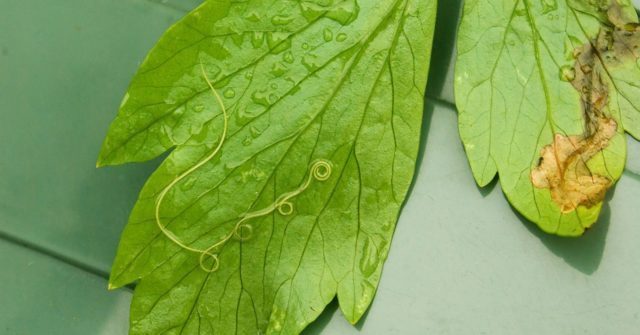

Nematodes damage the leaves of the plant, causing irregular dried spots to appear on them. Plants affected by the disease should be destroyed, and the top 2 cm of soil should be replaced. Sometimes you have to resort to more extreme measures - to transplant all the plants to another area.
To ward off slugs from the landing site, you should use standard methods: traps and barriers.
Feeding
Freshly planted seedlings do not need additional feeding. Feeding can be started no earlier than 1.5 years after rooting.
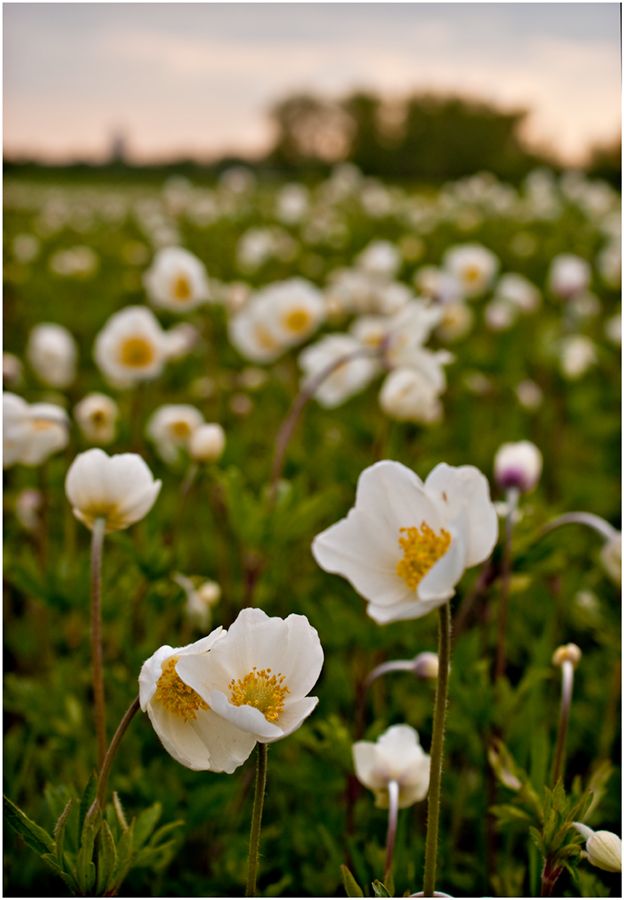

- It is highly discouraged to use manure as the main fertilizer. Its use has a detrimental effect on the condition of the seedlings;
- Liquid fertilizing based on mineral compounds has proven itself well. Its use has a beneficial effect on the process of bud formation;
- During active flowering, it needs additional nutrition with nutrients. It is best to feed with a complex consisting of several mineral fertilizers.
How is an anemone planted?
If gardeners can grow some flowers at home and plant them in open ground, then this is unlikely to work with an anemone. The best breeding method for these flowers is by dividing the bush. The bush must be dug up and then divided into parts, planted.
It is best to plant flowers in July. It is important to plant new bushes when they have green leaves.
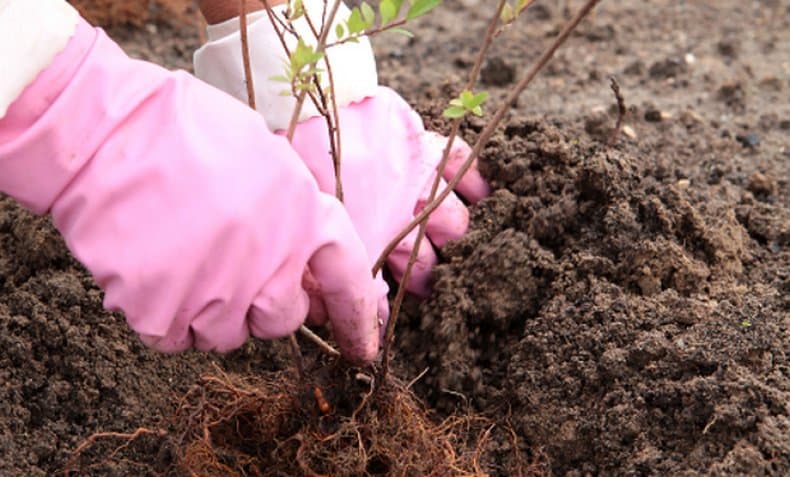

The seedling does not need to be buried deep in the ground. It is enough to dig a hole 5 cm deep, but you can also 8 or 10 cm deep.
“Advice! It is important that the root collar stays at ground level. "
If the owner wants to grow flowers from seeds, then they sow them in late autumn before winter. Flowers that propagate by cuttings with roots take root well on the site. It is best to plant them in the partial shade of tree crowns.
You can sow seeds in the spring, but you need to carry out cold stratification. It will take from 15 to 20 days and the sprouts will hatch, which will delight the gardener. Plants begin to bloom from 2 years of age.
Chemical composition
The chemical composition of the anemone is practically unknown. Anemone is one of the poisonous plants in nature, as it contains protoanemonin, tannin, and resins. The leaves also contain ranunculin, which, during the drying process, is divided into protoanemonin and glucose.
Not many people know that protoamonin is a poison. Outwardly, it is an oil-like liquid with a pungent odor. All these substances are found in the buttercup anemone.
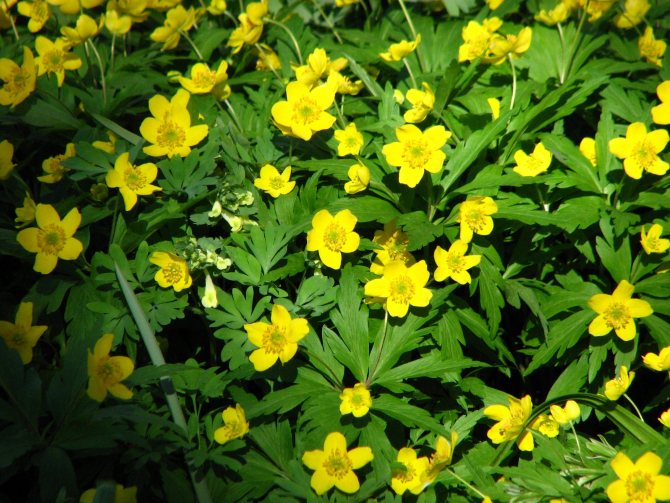

Yellow anemone

